Central European Time
Central European Time (CET), used in most parts of Europe and a few North African countries, is a standard time which is 1 hour ahead of Coordinated Universal Time (UTC). The time offset from UTC can be written as UTC+01:00. The same standard time, UTC+01:00, is also known as Middle European Time (MET, German: MEZ) and under other names like Berlin Time, Warsaw Time, Paris Time or Rome Time.
| Central European Time | |
|---|---|
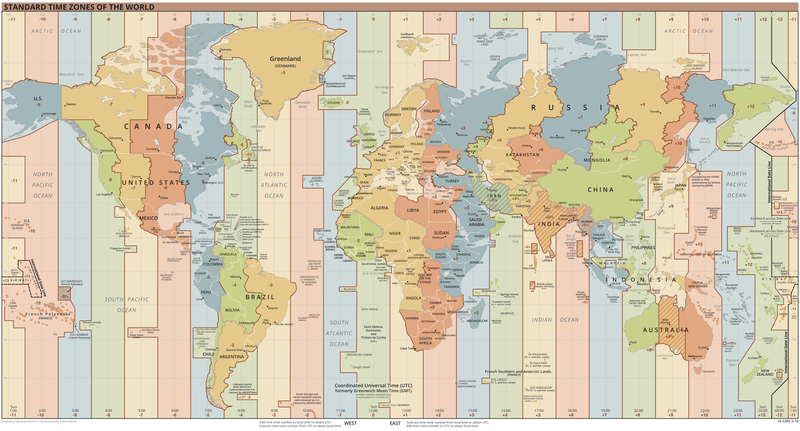 World map with the time zone highlighted | |
| UTC offset | |
| CET | UTC+01:00 |
| CEST | UTC+02:00 |
| Current time | |
| 06:04, 19 August 2020 CET [refresh] 07:04, 19 August 2020 CEST [refresh] | |
| Observance of DST | |
| DST is observed throughout this time zone. | |
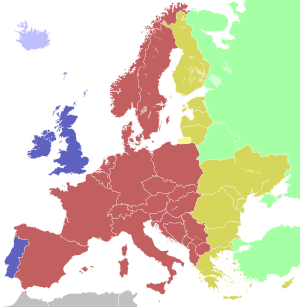
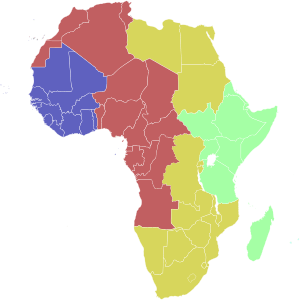
| -01:00 | Cape Verde Time[a] |
| ±00:00 | Greenwich Mean Time |
| +01:00 | West Africa Time |
| +02:00 | |
| +03:00 | East Africa Time |
| +04:00 |
b Mauritius and the Seychelles are to the east and north-east of Madagascar respectively.
The 15th meridian east is the central axis for UTC+01:00 in the world system of time zones.
As of 2011, all member states of the European Union observe summer time; those that during the winter use CET use Central European Summer Time (CEST) (or: UTC+02:00, daylight saving time) in summer (from last Sunday of March to last Sunday of October).[1]
A number of African countries use UTC+01:00 all year long, where it is called West Africa Time (WAT),[2] although Algeria, Morocco, and Tunisia also use the term Central European Time.[3]
Usage
Usage in Europe
Current usage
Central European Time is currently (updated 2017)[4] used in Albania, Andorra, Austria, Belgium, Bosnia and Herzegovina, Croatia, Czech Republic, Denmark, France, Germany, Hungary, Italy, Kosovo*, Liechtenstein, Luxembourg, North Macedonia, Malta, Monaco, Montenegro, Netherlands, Norway, Poland, San Marino, Serbia, Slovakia, Slovenia, Spain, Sweden and Switzerland.[3]
History
- 1884
- 1 October 1891
- 1 April 1893
- 1894
- 1895
- Norway adopts CET.[14]
- 1900
- Sweden adopts CET.[15]
- 1904
- 1914
- Albania adopts CET.[18]
- 1914–1918
- During World War I CET was implemented in all German-occupied territories.[19]
- 1920
- Lithuania adopts CET (but subsequently rescinded in 1940) and 1998−1999 again.[20]
- 1922
- Poland adopts CET.[21]
- 1940
After World War II Monaco, Andorra and Gibraltar implemented CET.[19]
Portugal used CET in the years 1966–1976 and 1992–1996.
- United Kingdom
The time around the world is based on Universal Coordinated Time (UTC) which is roughly synonymous with Greenwich Mean Time (GMT). From late March to late October, clocks in the United Kingdom are put forward by one hour for British Summer Time (BST). Since 1997, most of the European Union aligned with the British standards for BST.
In 1968[23] there was a three-year experiment called British Standard Time, when the UK and Ireland experimentally employed British Summer Time (GMT+1) all year round; clocks were put forward in March 1968 and not put back until October 1971.[24]
Central European Time is sometimes referred to as continental time in the UK.
Other countries
Several African countries use UTC+01:00 all year long, where it called West Africa Time (WAT), although Algeria, Morocco and Tunisia also use the term Central European Time, despite being located in North Africa.[3]
Between 2005 and 2008, Tunisia observed daylight saving time.[25] Libya also used CET during the years 1951–1959, 1982–1989, 1996–1997 and 2012–2013.
For other countries see UTC+01:00 and West Africa Time.
Discrepancies between official CET and geographical CET
| Colour | Legal time vs local mean time |
|---|---|
| 1 h ± 30 m behind | |
| 0 h ± 30 m | |
| 1 h ± 30 m ahead | |
| 2 h ± 30 m ahead | |
| 3 h ± 30 m ahead |
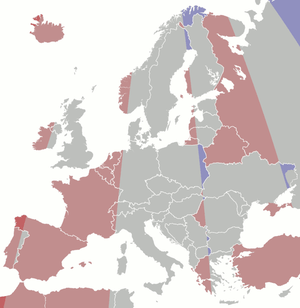
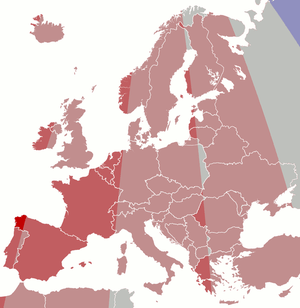
Legal, political and economic, as well as physical or geographical criteria are used in the drawing of time zones so official time zones rarely adhere to meridian lines. The CET time zone, were it drawn by purely geographical terms, would consist of exactly the area between meridians 7°30′ E and 22°30′ E. As a result, there are European locales that despite lying in an area with a "physical" or "nominal" UTC+01:00 time, actually use another time zone (UTC+02:00 in particular – there are no "physical" UTC+01:00 areas that employ UTC+00:00). Conversely, there are European areas that have gone for UTC+01:00, even though their "physical" time zone is UTC (typically), UTC−01:00 (westernmost Spain), or UTC+02:00 (e.g. the very easternmost parts of Norway, Sweden, Poland and Serbia). On the other hand, the people in Spain still have all work and meal hours one hour later than France and Germany even if they have the same time zone.[26] Following is a list of such "incongruences":
Historically Gibraltar maintained UTC+01:00 all year until the opening of the land frontier with Spain in 1982 when it followed its neighbour and introduced CEST.
Areas located within UTC+01:00 longitudes using other time zones
These areas are located between 7°30′ E and 22°30′ E ("physical" UTC+1)[27][28]
Areas using UTC+02:00
- The westernmost part of Greece, including the cities of Patras, Ioannina and the island of Corfu
- The westernmost parts of the Bulgarian provinces of Vidin and Kyustendil
- The westernmost part of Romania, including most of the area of the counties of Caraș-Severin, Timiș (capital Timișoara), Arad, and Bihor, as well as the westernmost tips of the counties of Mehedinți and Satu Mare
- The westernmost tip of Ukraine, near the border with Hungary and Slovakia, at the Ukrainian Transcarpathian Oblast (Zakarpattia Oblast), essentially comprising the city of Uzhhorod and its environs. (Although CET is used as local, non-official time in Transcarpathia).
- Western Lithuania, including the cities of Klaipėda, Tauragė, and Telšiai
- Western Latvia, including the cities of Liepāja and Ventspils
- The westernmost parts of the Estonian islands of Saaremaa and Hiiumaa, including the capital of the Saare County, Kuressaare
- The southwestern coast of Finland, including the city of Turku; also the Åland islands (of Finnish jurisdiction) – the Åland islands are the westernmost locale applying EET in the whole of Europe
- The northwesternmost part of Finland, including Kilpisjärvi and Kaaresuvanto.
- The Russian exclave of Kaliningrad Oblast, excluding however its easternmost slice (the city of Nesterov is east of 22°30′ E, but that of Krasnoznamensk is not)
Areas located outside UTC+01:00 longitudes using UTC+01:00 time
| Look up nominal in Wiktionary, the free dictionary. |
These areas are located either west of 7°30′ E or east of 22°30′ E (outside nominal UTC+01:00)[27][28]
Areas between 22°30′ W and 7°30′ W (nominal UTC−01:00)
- The westernmost part of mainland Spain (Galicia, e.g. the city of A Coruña); Cape Finisterre and nearby points in Galicia, at 9°18′ W, are the westernmost places of CET in Spain.
- The Norwegian island of Jan Mayen lies entirely within this area and extends nearly as far west as Cape Finisterre, with its western tip at 9°5′ W and its eastern tip at 7°56′ W.
- Western Morocco including the city of Casablanca, at 7°35′ W. CET usage in Morocco extends as west as 13°10′ W.
- The entirety of Western Sahara with its western tip at 17°6′ W and its eastern tip at 8°40′ W.
Areas between 7°30′ W and 7°30′ E (nominal UTC+00:00)
- Andorra
- Belgium
- France, with the small exception of two separate easternmost parts of the mainland, one along eastern Alsace, incl. Strasbourg and the other in parts of the Alpes-Maritimes department, as well as the island of Corsica. Overseas departments of France use local times.
- The very westernmost part of Germany, incl. the cities of Saarbrücken, Düsseldorf, Cologne, Aachen, and Trier
- The absolutely westernmost part of Italy, incl. the cities of Aosta in Aosta Valley and Cuneo in Piedmont
- Luxembourg
- Monaco
- Netherlands
- The westernmost part of Norway, incl. the cities of Bergen and Stavanger
- Spain, except for the westernmost part of the mainland (see above) and the Canary Islands (which are further than 7°30′ W and use UTC+00:00).
- Gibraltar
- The part of Switzerland west of Bern (inclusive), also incl. cities such as Basel, Geneva, Lausanne, and Fribourg
- Most of Algeria including its capital Algiers.
Areas between 22°30′ E and 37°30′ E (nominal UTC+02:00)
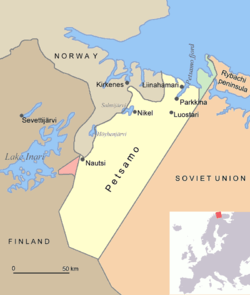
- The easternmost part of North Macedonia, including the city of Strumica
- The easternmost part of Serbia, in the Pirot District, including the city of Pirot, and small easternmost parts of Bor District.
- The easternmost tips of Hungary and Slovakia, bordering to the north and south respectively the Ukrainian Transcarpathian Oblast (Zakarpattia Oblast), a bit to the east of Vásárosnamény, Hungary – Uzhhorod, Ukraine (both at 22°18′ E) line
- The easternmost part of Poland, including the cities of Lublin and Białystok
- The northeast of Sweden, in the Norrbotten province, including the cities of Kalix and Haparanda
- The northeast of Norway, lying north of Finland, roughly coinciding with the county of Finnmark. The easternmost town in Norway, Vardø, lies at 30°51′ E, which is so far east, so as to be east even of the central meridian of EET (UTC+02:00), i.e. east of Istanbul and Alexandria. The sun reaches its highest point at 10:56 (when not DST), although the sun does not vary so much in height at the latitude 70°N.
The Norwegian–Russian and the Polish-Belarussian border are the only places where CET (UTC+1/+2) borders Moscow time (UTC+03:00), resulting in a two hours time change (or one hour in summer) for the travellers crossing that border. - There is a "tri-zone" point (where UTC+01:00, UTC+02:00, and UTC+03:00 meet, winter times) at the Norway–Finland–Russia tripoint near Muotkavaara. During the summer Finland and Russia both have UTC+03:00.
See also
- Summer Time in Europe
- Other countries and territories in UTC+1 time zone
References
- "Europe Starts Daylight Saving on March 27, 2011". www.timeanddate.com. Retrieved 2018-07-19.
- "WAT – West Africa Time (Time Zone Abbreviation)". www.timeanddate.com. Retrieved 2018-07-19.
- "Central European Time Zone - CET". WorldTimeServer.com. 2015-11-19. Retrieved 2018-07-19.
- CET – Central European Time / European Central Time (Standard Time)
- "Time Zone & Clock Changes in Belgrade, Serbia". www.timeanddate.com. Retrieved 2018-07-19.
- Kunt, Miroslav (2004). "Studie - Zavedení středoevropského času". archiv.kvalitne.cz (in Czech). Retrieved 28 June 2020.
- Bartky, Ian R. (2007). One Time Fits All: The Campaigns for Global Uniformity. Stanford University Press. pp. 126–7. ISBN 0804756422. Retrieved 18 August 2015.
- "Time Zone & Clock Changes in Rome, Italy". www.timeanddate.com. Retrieved 2018-07-19.
- "Time Zone & Clock Changes in Valletta, Malta". www.timeanddate.com. Retrieved 2018-07-19.
- "Time Zone & Clock Changes in Vienna, Vienna, Austria". www.timeanddate.com. Retrieved 2018-07-19.
- Messerli, Jakob. "Zeitsysteme". HLS-DHS-DSS.CH (in German). Retrieved 2018-07-19.
- "dullophob". www.dullophob.com. Archived from the original on 2018-07-19. Retrieved 2018-07-19.
- "Time Zone & Clock Changes in Copenhagen, Denmark". www.timeanddate.com. Retrieved 2018-07-19.
- "Daylight Saving Time Changes 1895 in Oslo, Norway". www.timeanddate.com. Retrieved 2018-07-19.
- "Time Zone & Clock Changes in Stockholm, Sweden". www.timeanddate.com. Retrieved 2018-07-19.
- "Daylight Saving Time Changes 1904 in Luxembourg, Luxembourg". www.timeanddate.com. Retrieved 2018-07-20.
- "Daylight Saving Time Changes 1918 in Luxembourg, Luxembourg". www.timeanddate.com. Retrieved 2018-07-20.
- "Time Zone & Clock Changes in Tirana, Albania". www.timeanddate.com. Retrieved 2018-07-20.
- "CET - Central European Time". www.thetimenow.com. Retrieved 2018-07-20.
- "Time Zone & Clock Changes in Vilnius, Lithuania". www.timeanddate.com. Retrieved 2018-07-20.
- "Time Changes in Poland 2017". www.vercalendario.info. Retrieved 2018-07-20.
- Bartky, Ian R. (2007). One Time Fits All: The Campaigns for Global Uniformity. Stanford University Press. pp. 130, 134. ISBN 0804756422. Retrieved 18 August 2015.
- "Summer Time all the time". Birmingham Daily Post. England. 13 February 1968. Retrieved 16 July 2018 – via British Newspaper Archive.
- "Clocks to be turned back". Birmingham Daily Post. England. 2 October 1971. Retrieved 16 July 2018 – via British Newspaper Archive.
- "Daylight Saving Time Changes 2005 in Tunis, Tunisia". www.timeanddate.com. Retrieved 2018-07-20.
- Purdy, Chase. "Spain spent the last 76 years in the wrong time zone—and it's not healthy for workers". Quartz. Retrieved 2018-07-20.
- "Greece Time Zone". www.timetemperature.com. Retrieved 2018-07-20.
- "Europe Time Zones Map With Zone - madriver.me". madriver.me. Archived from the original on 2018-07-20. Retrieved 2018-07-20.